2022 TOYOTA SUPRA service
[x] Cancel search: servicePage 16 of 498

141-1. NOTES
Commission via the vehicle manu-
facturer, e.g. fuel or energy con-
sumption and the distance covered.
The registered keeper can refuse to
provide this data for this purpose.
Depending on the equipment,
mobile devices such as
smartphones can be connected to
the vehicle and used to control
vehicle functions, for example
Toyota Supra Connect. For exam-
ple, sound and images from the
mobile device can be played back
and displayed through the multime-
dia system in the vehicle.
Selected information is transferred
to the mobile device at the same
time. Depending on the type of inte-
gration, this includes position data
and other general vehicle informa-
tion, for example. This optimises
the way in which selected apps, for
example navigation or music play-
back, work. How the data is pro-
cessed further is determined by the
provider of the particular app being
used.
If the vehicle has a wireless net-
work connection, this enables data
to be exchanged between the vehi-
cle and other systems, for example
with Toyota Supra Connect.
In the case of online services pro-
vided by the manufacturer of the
vehicle, the respective functions
are described at a suitable point, for
example, in the Owner's Handbook,
on the manufacturer's web page.
The relevant legal information per-
taining to data protection is also
provided.
Personal data may be used to pro-
vide online services. Data is
exchanged over a secure connec-
tion, for example with the data sys-
tems of the vehicle manufacturer
intended for this purpose.
Any collection, processing and use
of personal data above and beyond
that needed to provide the services
always requires legal permission, a
contractual agreement or consent
of the user.
Toyota Supra Conn ect networks the
vehicle with a whole host of digital
services. When used, only the data
saved in the vehicle that is required
to perform the agreed service is
transferred online, for example
information on iden tifying and locat-
ing the vehicle. The basis is a con-
tractual agreement with the user.
In individual cases, the transfer of
Mobile devices
Services
General
Services from the vehicle manu-
facturer
Toyota Supra Connect
Page 17 of 498
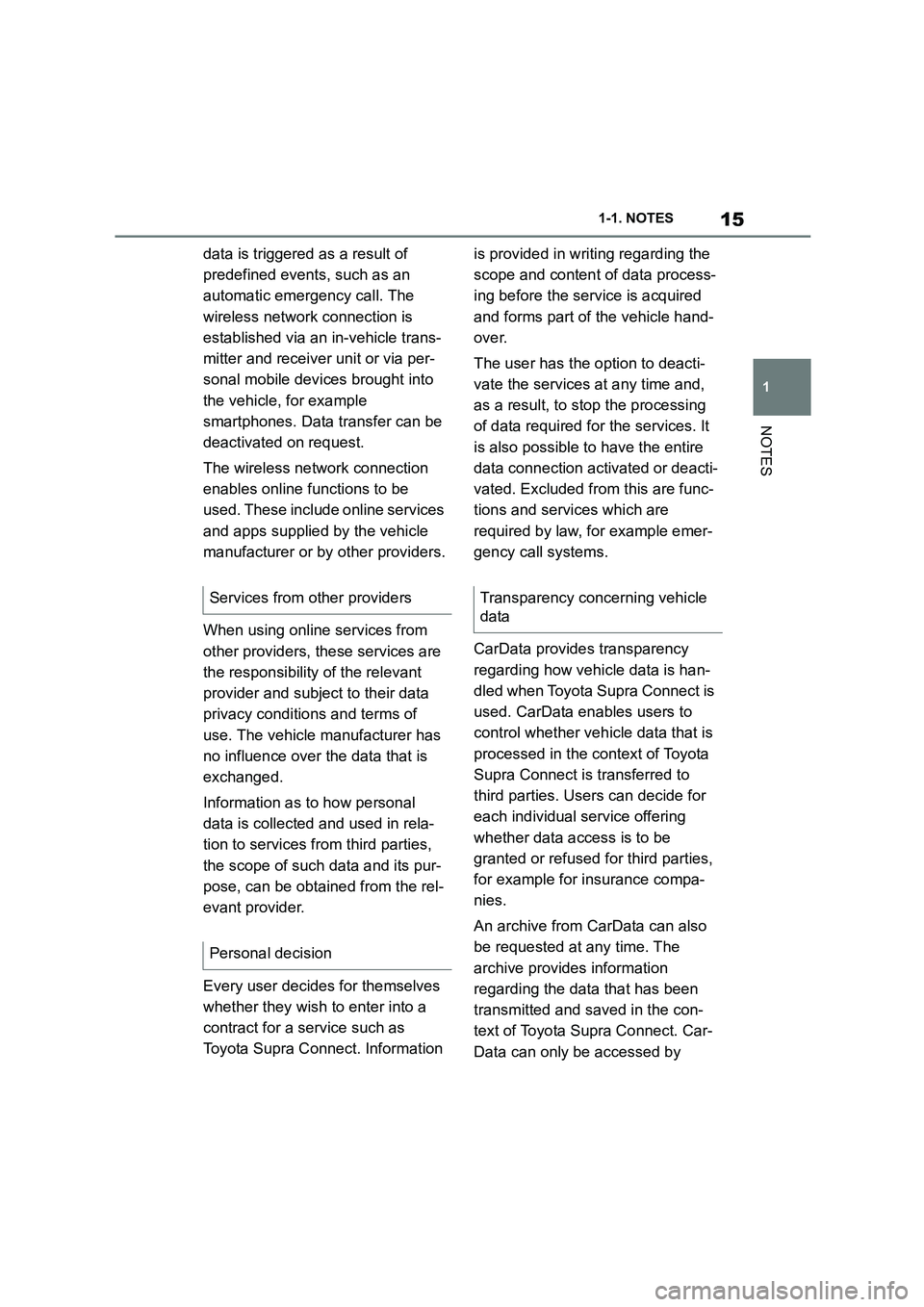
15
1
1-1. NOTES
NOTES
data is triggered as a result of
predefined events, such as an
automatic emergency call. The
wireless network connection is
established via an in-vehicle trans-
mitter and receiver unit or via per-
sonal mobile devices brought into
the vehicle, for example
smartphones. Data transfer can be
deactivated on request.
The wireless network connection
enables online functions to be
used. These include online services
and apps supplied by the vehicle
manufacturer or by other providers.
When using online services from
other providers, these services are
the responsibility of the relevant
provider and subject to their data
privacy conditions and terms of
use. The vehicle manufacturer has
no influence over the data that is
exchanged.
Information as to how personal
data is collected and used in rela-
tion to services from third parties,
the scope of such data and its pur-
pose, can be obtained from the rel-
evant provider.
Every user decides for themselves
whether they wish to enter into a
contract for a service such as
Toyota Supra Connect. Information
is provided in writing regarding the
scope and content of data process-
ing before the service is acquired
and forms part of the vehicle hand-
over.
The user has the option to deacti-
vate the services at any time and,
as a result, to stop the processing
of data required fo r the services. It
is also possible to have the entire
data connection activated or deacti-
vated. Excluded from this are func-
tions and services which are
required by law, for example emer-
gency call systems.
CarData provides transparency
regarding how vehicle data is han-
dled when Toyota Supra Connect is
used. CarData enables users to
control whether vehicle data that is
processed in the context of Toyota
Supra Connect is transferred to
third parties. Users can decide for
each individual service offering
whether data access is to be
granted or refused for third parties,
for example for insurance compa-
nies.
An archive from CarData can also
be requested at any time. The
archive provides information
regarding the data that has been
transmitted and saved in the con-
text of Toyota Supra Connect. Car-
Data can only be accessed by
Services from other providers
Personal decision
Transparency concerning vehicle
data
Page 18 of 498

161-1. NOTES
third-party providers via servers of
the vehicle manufacturer. No direct
access to the vehicle and its data is
granted.
More information on CarData is
available on the Toyota Supra Con-
nect customer portal.
The eCall emergency call system
required by law enables manual or
automatic emergency calls to be
issued in the event of accidents, for
example.
The emergency calls are answered
by the public rescue coordination
centre.
For information on the eCall statu-
tory on-board emergency call sys-
tem based on the 112 emergency
call, as well as its operation and its
functions, see the chapter on emer-
gency calls.
The eCall service based on the 112
emergency call is a public service
of general interest and is provided
free of charge.
If a serious accident occurs, the
eCall statutory emergency call sys-
tem is activated automatically by
on-board sensors as a standard
feature. It is also triggered automat-
ically if the vehicle is equipped with
an intelligent emergency call sys-
tem that fails to wo rk in the event of
a serious accident.
The eCall statutory emergency call
system can also be triggered man-
ually if required.
If a critical system failure occurs
that would put the eCall statutory
emergency call system out of oper-
ation, the passengers receive a
warning.
For further information:
• Emergency call, see page 353.
• Malfunction, see page 354.
The eCall statutory emergency call
system processes personal data in
accordance with the following regu-
lations:
• Protection of personal data: Reg-
ulation 2016/679/EU of the Euro-
pean Parliament and of the
Council.
• Protection of personal data:
Directive 2002/58/EC of the
European Parliament and of the
Council.
Personal data is only processed for
the purpose of transmitting eCall
emergency calls to the standard-
ised European emergency call
number 112.
Statutory emergency call
system
Principle
General
Information on data processing
Page 19 of 498
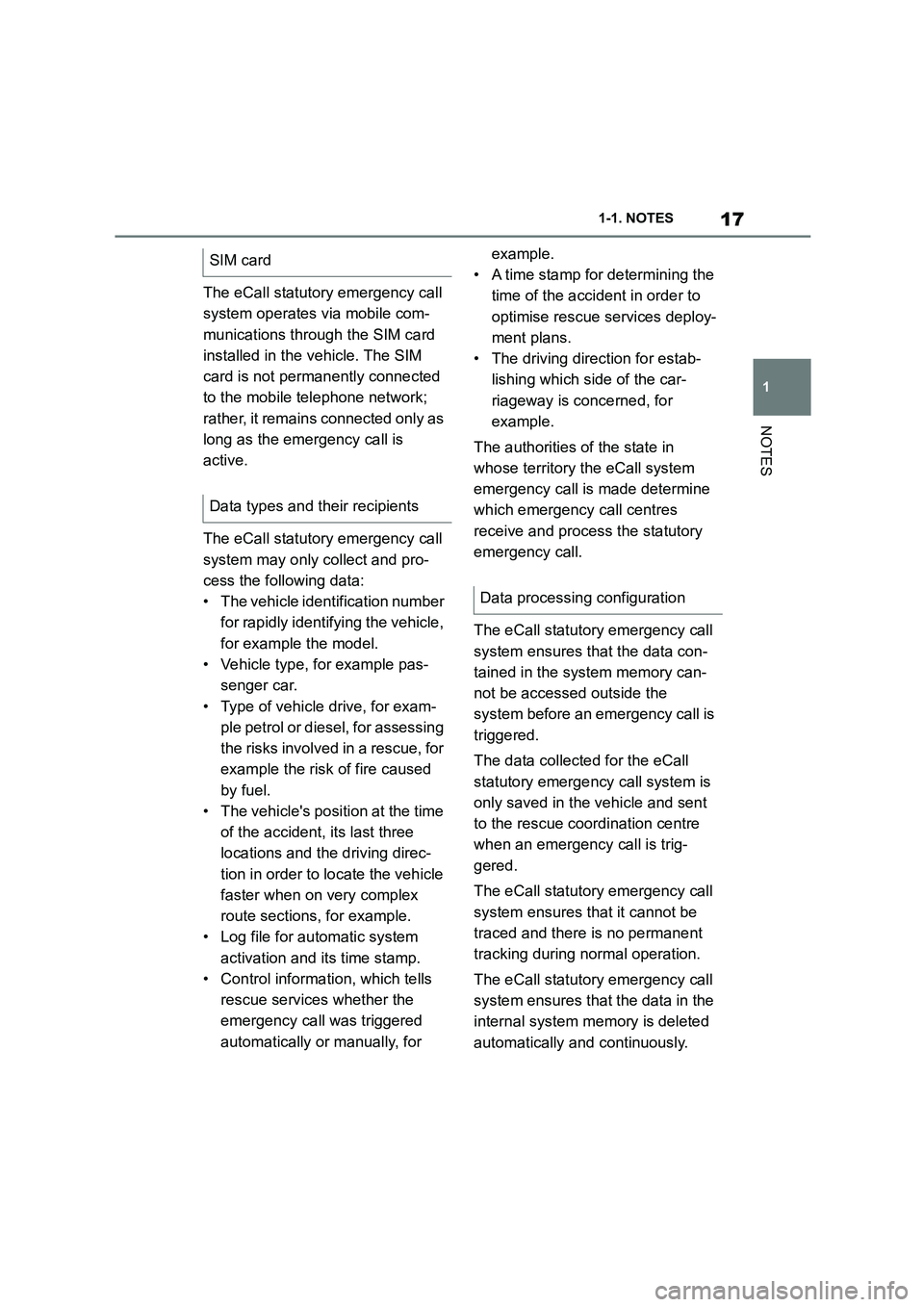
17
1
1-1. NOTES
NOTES
The eCall statutory emergency call
system operates via mobile com-
munications through the SIM card
installed in the vehicle. The SIM
card is not permanently connected
to the mobile telephone network;
rather, it remains connected only as
long as the emergency call is
active.
The eCall statutory emergency call
system may only collect and pro-
cess the following data:
• The vehicle identification number
for rapidly identifying the vehicle,
for example the model.
• Vehicle type, for example pas-
senger car.
• Type of vehicle drive, for exam-
ple petrol or diesel, for assessing
the risks involved in a rescue, for
example the risk of fire caused
by fuel.
• The vehicle's position at the time
of the accident, its last three
locations and the driving direc-
tion in order to locate the vehicle
faster when on very complex
route sections, for example.
• Log file for automatic system
activation and its time stamp.
• Control informat ion, which tells
rescue services whether the
emergency call was triggered
automatically or manually, for
example.
• A time stamp for determining the
time of the accident in order to
optimise rescue services deploy-
ment plans.
• The driving direction for estab-
lishing which side of the car-
riageway is concerned, for
example.
The authorities of the state in
whose territory the eCall system
emergency call is made determine
which emergency call centres
receive and process the statutory
emergency call.
The eCall statutory emergency call
system ensures that the data con-
tained in the system memory can-
not be accessed outside the
system before an emergency call is
triggered.
The data collected for the eCall
statutory emergency call system is
only saved in the vehicle and sent
to the rescue coordination centre
when an emergency call is trig-
gered.
The eCall statutory emergency call
system ensures that it cannot be
traced and there is no permanent
tracking during normal operation.
The eCall statutory emergency call
system ensures that the data in the
internal system memo ry is deleted
automatically and continuously.
SIM card
Data types and their recipients
Data processing configuration
Page 21 of 498
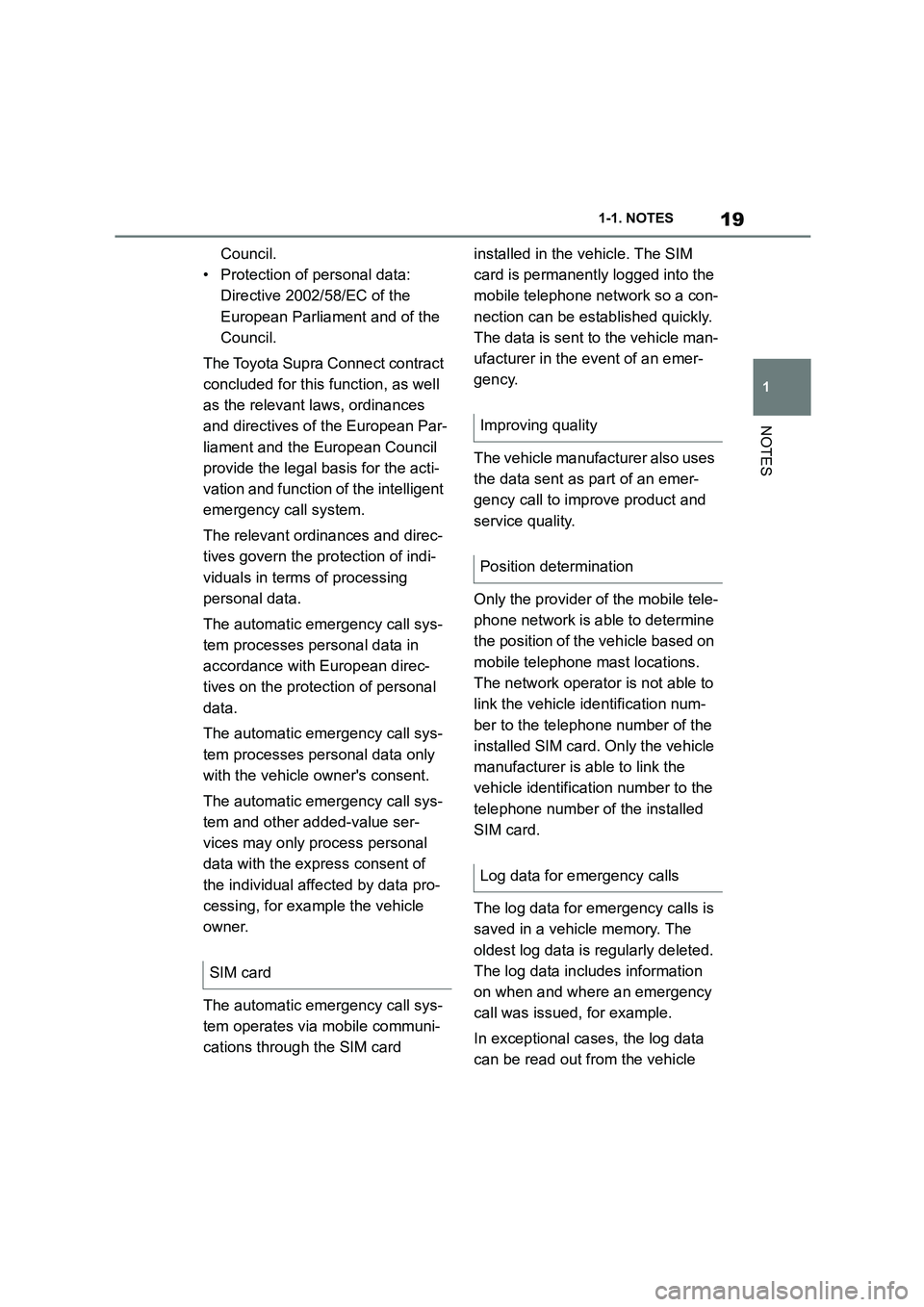
19
1
1-1. NOTES
NOTES
Council.
• Protection of personal data:
Directive 2002/58/EC of the
European Parliament and of the
Council.
The Toyota Supra Connect contract
concluded for this function, as well
as the relevant laws, ordinances
and directives of the European Par-
liament and the European Council
provide the legal basis for the acti-
vation and function of the intelligent
emergency call system.
The relevant ordinances and direc-
tives govern the protection of indi-
viduals in terms of processing
personal data.
The automatic emergency call sys-
tem processes personal data in
accordance with European direc-
tives on the protection of personal
data.
The automatic emergency call sys-
tem processes personal data only
with the vehicle owner's consent.
The automatic emergency call sys-
tem and other added-value ser-
vices may only process personal
data with the express consent of
the individual affected by data pro-
cessing, for example the vehicle
owner.
The automatic emergency call sys-
tem operates via mobile communi-
cations through the SIM card
installed in the vehicle. The SIM
card is permanently logged into the
mobile telephone network so a con-
nection can be established quickly.
The data is sent to the vehicle man-
ufacturer in the event of an emer-
gency.
The vehicle manufacturer also uses
the data sent as part of an emer-
gency call to improve product and
service quality.
Only the provider of the mobile tele-
phone network is able to determine
the position of the vehicle based on
mobile telephone mast locations.
The network operator is not able to
link the vehicle identification num-
ber to the telephone number of the
installed SIM card. Only the vehicle
manufacturer is able to link the
vehicle identification number to the
telephone number of the installed
SIM card.
The log data for emergency calls is
saved in a vehicle memory. The
oldest log data is regularly deleted.
The log data includes information
on when and where an emergency
call was issued, for example.
In exceptional cases, the log data
can be read out from the vehicle
SIM card
Improving quality
Position determination
Log data for emergency calls
Page 22 of 498

201-1. NOTES
memory. It is usually only possible
for log data to be read out with a
court order and if the corresponding
devices are directly connected to
the vehicle.
The system has been designed so
that an emergency call is triggered
automatically following an accident
of a certain severity, which is
detected by the sensors in the vehi-
cle.
If an emergency call is made by the
automatic emergency call system,
the same information is conveyed
to the appointed emergency call
centre as is normally conveyed to
the public rescue coordination cen-
tre by the eCall statutory emer-
gency call system.
Furthermore, the automatic emer-
gency call system also conveys the
following additional information to
an emergency call centre appointed
by the vehicle manufacturer and,
where applicable, to the public res-
cue coordination centre:
• Accident data, for example the
direction of th e collision as
detected by the vehicle sensors
in order to facilitate the rescue
services deployment plans.
• Contact data, for example the
telephone number of the
installed SIM card and the
driver's telephone number, if
available, so that those involved
in the accident can be contacted
quickly if necessary.
The data relating to an emergency
call that has been placed is trig-
gered in the vehicle. The data con-
tains information about the
emergency call, for example the
place and time it was issued.
The emergency call centre saves
audio recordings of the emergency
call.
Audio recordings of the customer
are saved for 24 hours, in case
details of the emergency call need
to be analysed. A fter that, the audio
recordings are deleted. Audio
recordings of the emergency call
centre employee are saved for 24
hours for quality assurance pur-
poses.
The data obtained in the context of
an automatic emergency call is only
used to process the emergency
call. If legally obliged to do so, the
vehicle manufactur er will disclose
the data it has processed and,
where applicable , still has saved.
Automatic emergency call
Sent information
Data storage
Disclosure of personal data
Page 28 of 498
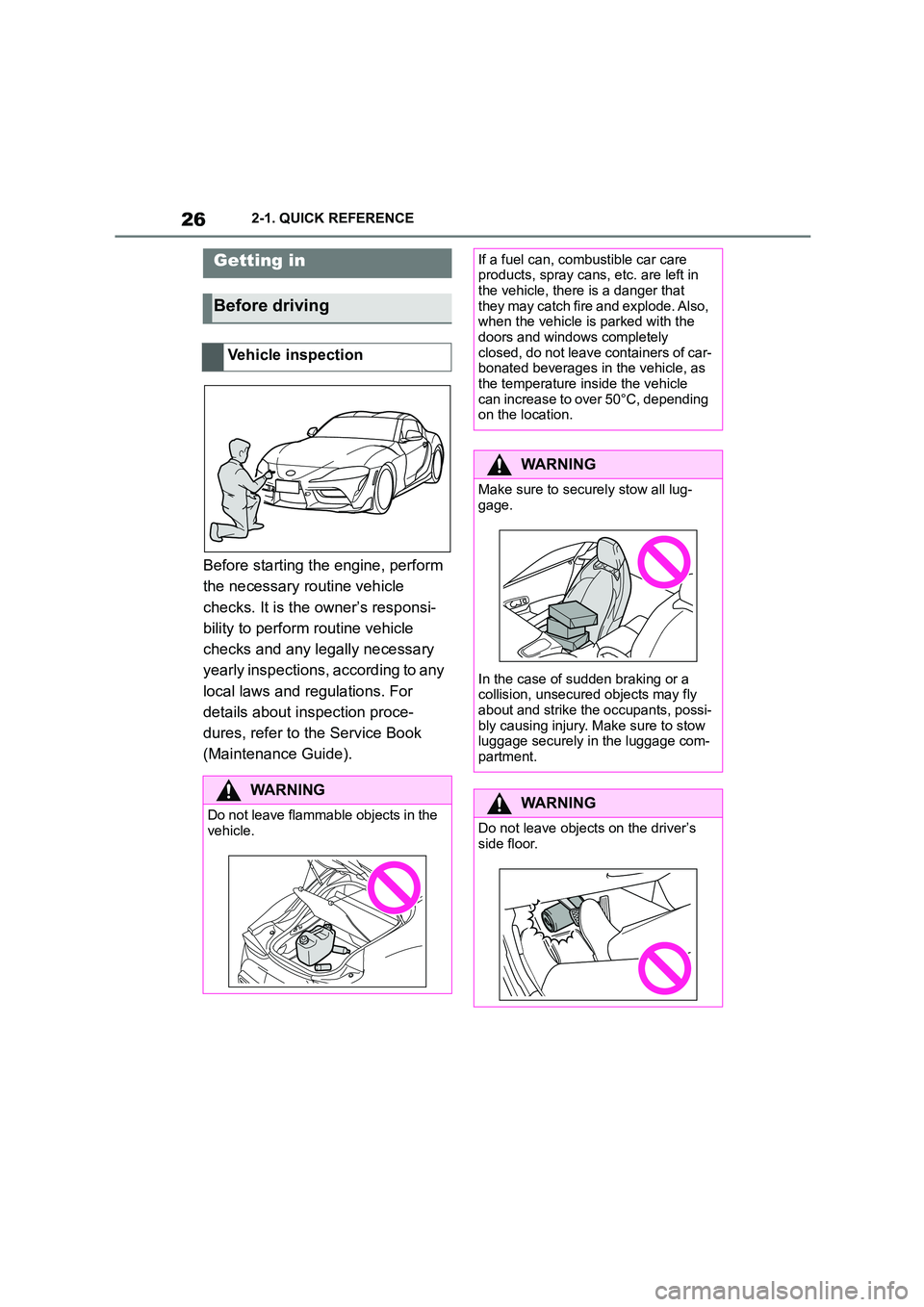
262-1. QUICK REFERENCE
2-1.QUICK REFERENCE
Before starting the engine, perform
the necessary routine vehicle
checks. It is the owner’s responsi-
bility to perform routine vehicle
checks and any legally necessary
yearly inspections, according to any
local laws and regulations. For
details about inspection proce-
dures, refer to the Service Book
(Maintenance Guide).
Getting in
Before driving
Vehicle inspection
WA R N I N G
Do not leave flammable objects in the vehicle.
If a fuel can, combustible car care products, spray cans, etc. are left in
the vehicle, there is a danger that
they may catch fire and explode. Also, when the vehicle is parked with the
doors and windows completely
closed, do not leave containers of car- bonated beverages in the vehicle, as
the temperature inside the vehicle
can increase to over 50°C, depending on the location.
WA R N I N G
Make sure to secu rely stow all lug-
gage.
In the case of sudden braking or a
collision, unsecure d objects may fly
about and strike the occupants, possi- bly causing injury. Ma ke sure to stow
luggage securely in the luggage com-
partment.
WA R N I N G
Do not leave objects on the driver’s
side floor.
Page 44 of 498
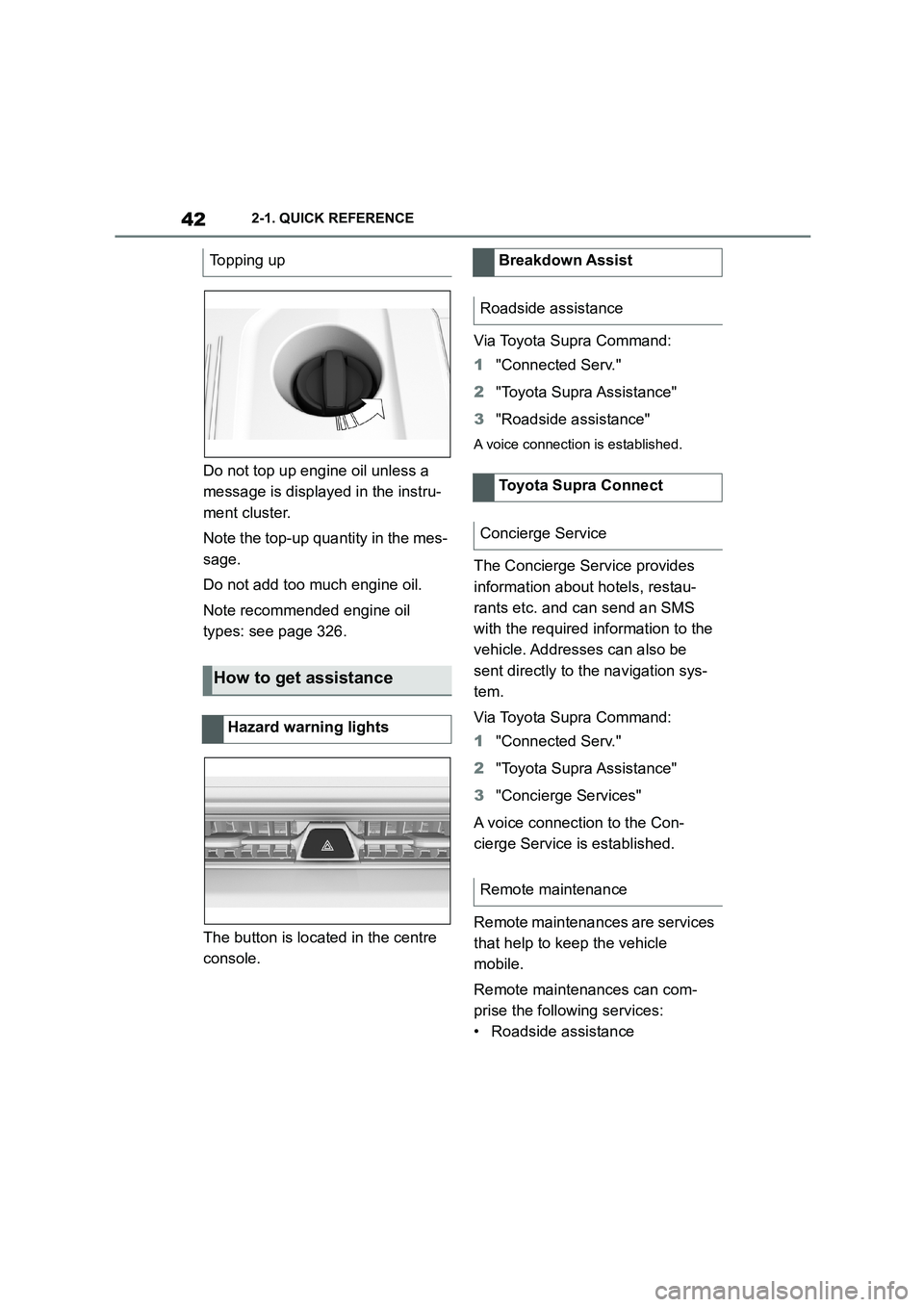
422-1. QUICK REFERENCE
Do not top up engine oil unless a
message is displayed in the instru-
ment cluster.
Note the top-up quantity in the mes-
sage.
Do not add too much engine oil.
Note recommended engine oil
types: see page 326.
The button is located in the centre
console.
Via Toyota Supra Command:
1 "Connected Serv."
2 "Toyota Supra Assistance"
3 "Roadside assistance"
A voice connection is established.
The Concierge Service provides
information about hotels, restau-
rants etc. and can send an SMS
with the required information to the
vehicle. Addresses can also be
sent directly to the navigation sys-
tem.
Via Toyota Supra Command:
1 "Connected Serv."
2 "Toyota Supra Assistance"
3 "Concierge Services"
A voice connection to the Con-
cierge Service is established.
Remote maintenances are services
that help to keep the vehicle
mobile.
Remote maintenances can com-
prise the following services:
• Roadside assistance
Topping up
How to get assistance
Hazard warning lights
Breakdown Assist
Roadside assistance
Toyota Supra Connect
Concierge Service
Remote maintenance